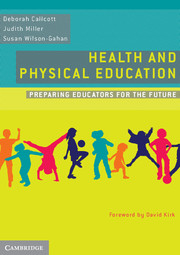Book contents
- Frontmatter
- Foreword
- Contents
- About the authors
- Acknowledgments
- Chapter 1 Introduction
- Chapter 2 The foundation of movement skills
- Chapter 3 Teaching inclusively
- Chapter 4 What all teachers need to know about movement
- Chapter 5 Pedagogy
- Chapter 6 Planning for teaching and learning
- Chapter 7 ICT and general capabilities in the Australian Curriculum
- Chapter 8 Assessment in health and physical education
- Chapter 9 Health education
- Glossary
- Bibliography
- Index
- References
Chapter 5 - Pedagogy
- Frontmatter
- Foreword
- Contents
- About the authors
- Acknowledgments
- Chapter 1 Introduction
- Chapter 2 The foundation of movement skills
- Chapter 3 Teaching inclusively
- Chapter 4 What all teachers need to know about movement
- Chapter 5 Pedagogy
- Chapter 6 Planning for teaching and learning
- Chapter 7 ICT and general capabilities in the Australian Curriculum
- Chapter 8 Assessment in health and physical education
- Chapter 9 Health education
- Glossary
- Bibliography
- Index
- References
Summary
Learning objectives
By engaging with the text in this chapter, students will be able to:
describe performance pedagogy
understand and apply the Spectrum of Teaching Styles first developed by Mosston
describe the four levels of the functional curriculum, and understand the implications of this model
describe critical pedagogy
understand and apply models-based practice
critically analyse personal histories and apply to their own (future) teaching practice.
Casey is in her first year of teaching at the local early childhood centre. She notices that some of the children at the centre have excellent gross motor skills. She also sees several children with poor coordination. The parents of the poorly coordinated boys are concerned and want Casey to help their sons. The parents of the poorly coordinated girls don’t mention the lack of skills to Casey. The boys dominate the equipment at playtime. How can Casey address the disparity in skill levels and enhance the girls’ experience? Casey recalls her pre-service teacher educator presented a range of approaches to teaching physical education, but she lacks confidence in applying these approaches. What can she do?
Jennie has been working with Year 4 this year. Although some sporty children are in her class, the gap is widening between the skilled and those disinterested in the game play. Jennie is seeking new ways of teaching physical education to close this gap in attitude and skill levels and confront the rising behaviour management challenges. Where can she look to find answers?
John is teaching physical education at the local high school and is frustrated by the disparate skill levels and varied attitudes of the students entering his school in Year 7. It seems some primary feeder schools are failing to teach fundamental motor skills. Many students are disinterested in physical education and some of the girls always have notes from parents excusing them from participation. John is searching for a way to engage the students and he believes the first thing he needs to do is help them increase their skill levels. What pedagogical strategies can he adopt to progress all the students in his class?
- Type
- Chapter
- Information
- Health and Physical EducationPreparing Educators for the Future, pp. 77 - 97Publisher: Cambridge University PressPrint publication year: 2012



